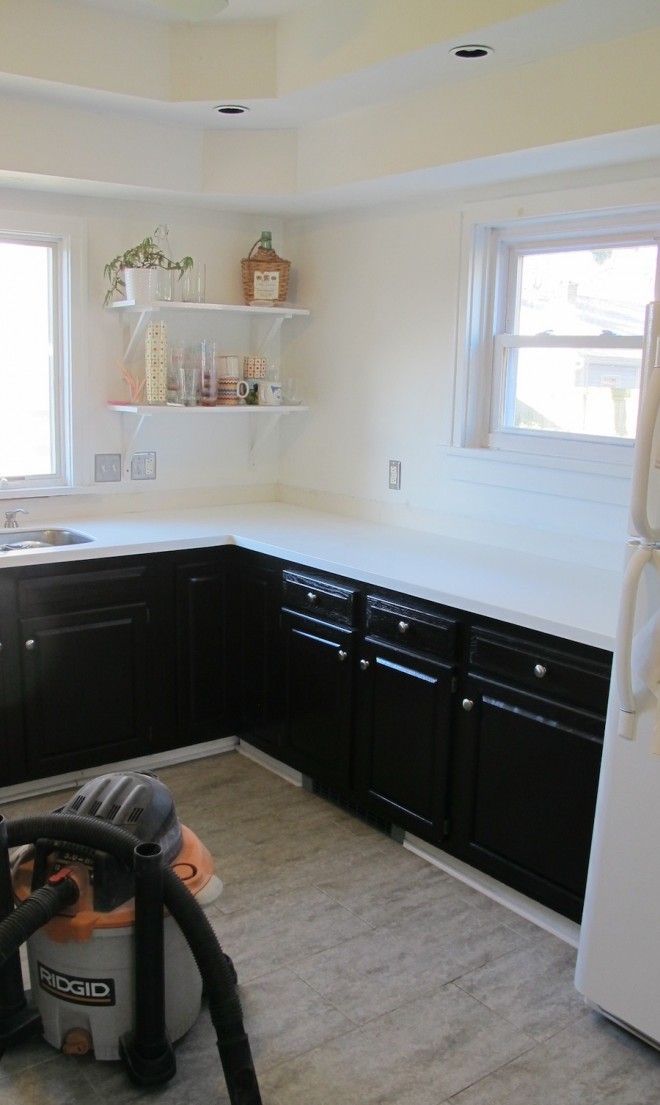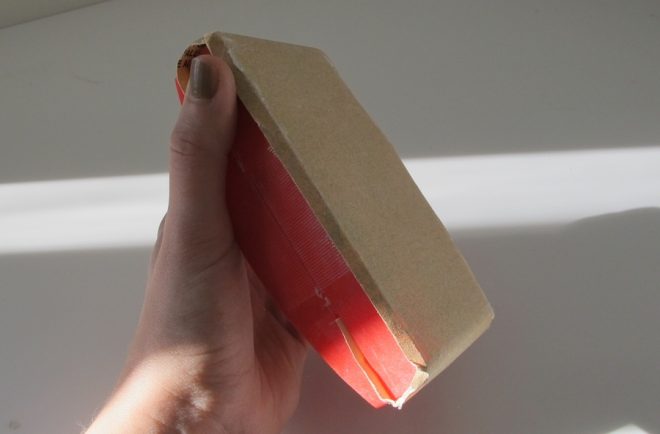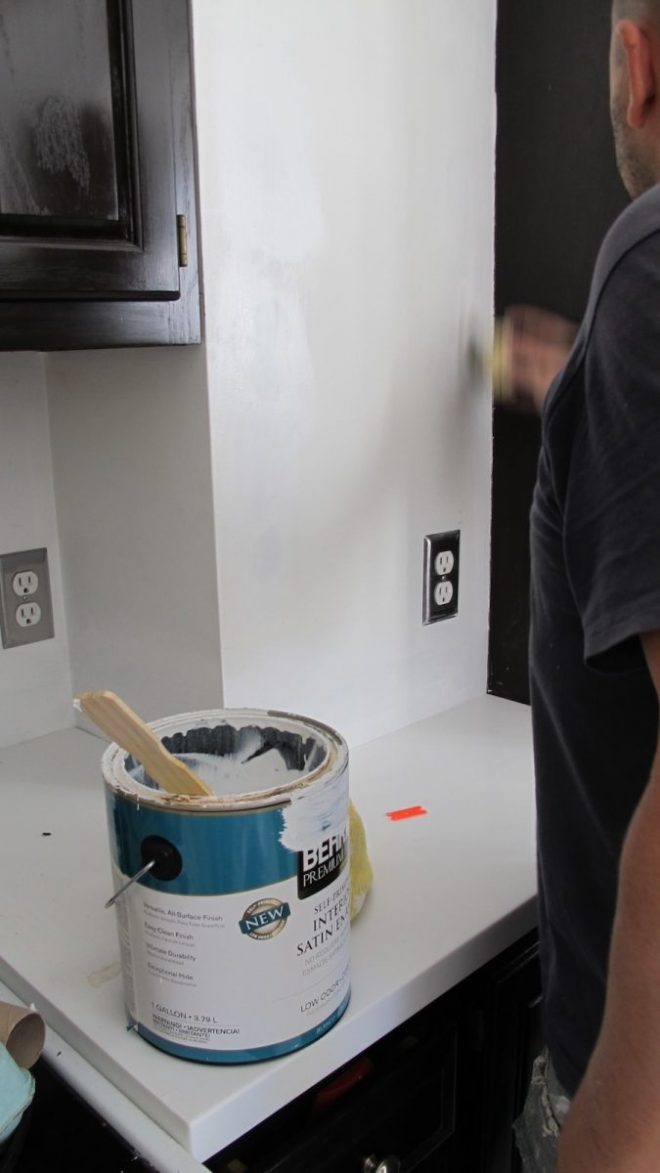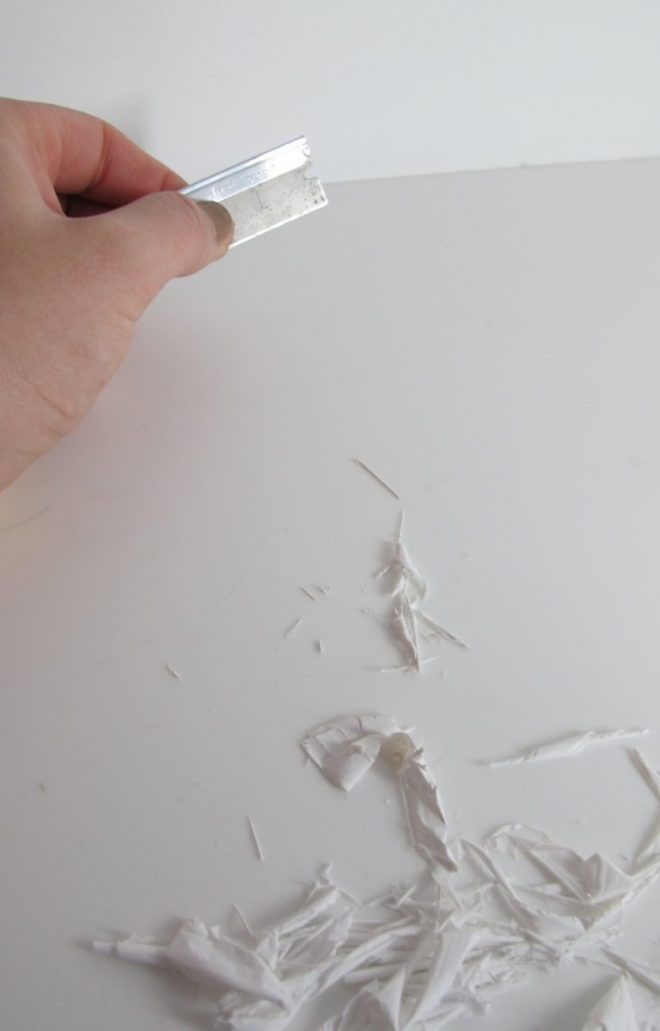How To Repair Drywall After Removing Laminate Backsplash
Editor's update: Peek at our finished kitchen in this post!
Leading up to last Friday's photo shoot, a shoot for which I'm still sworn to a degree of secrecy, we knew we had a big task looming. And there's nothing quite like the imminent stress of a major house repair timed so closely to a substantial, professional production. Hold everything, cue the stress, cue the mocha-infusion, and watch me as I put my hands on my face Kevin McAllister-style.
In any case, let's go back a few weeks and remind you that we knew that removing the old countertop with its backsplash and then choosing voluntarily to install a new countertop without a backsplash meant that we'd be dealing with a damaged wall situation, and the problem was apparent right away. That's no backsplash in this next photo, that's the damaged wall that was hidden behind the old laminate backsplash.

The short gap on the wall between the new countertop and the existing paint color was totally obvious, but what's not immediately evidenced by these photos that the variance is actually a whole ridge of paint, a little hardened paint mountain, if you will, as multiple layers of paint that had been applied to the wall over the years, but only down to the start of the old backsplash. The wall behind the backsplash? Plain drywall, with some sort of beige primer over it. Lovely. Beige, beige-beige-beige.
There's a whole extra step I realize I'm inadvertently leaving out of this post, that being the one where I completely disguised the fact that the original oak cabinetry was popping through in a few places. I'll be back later in the week with a quick how-do-you-do on that topic.

In the few weeks since we've had the countertop replaced, we've wavered quietly about what we should actually do to repair the section of the wall that was once covered by functional backsplash. We flung questions and scenarios back and forth at eachother 24/7, still never completely agreeing on the decided direction until Thursday morning, a mere day before we were scheduled to host the photo shoot. Was the variance in the painted wall and the original drywall so much that we'd never be able to make it look perfect? Should we resort to tile to cover the whole situation? We like tile, but could we pick/buy/install it quick enough without doing something regrettable? Tile's a bitch to take down if it ends up looking like poop, and the thought of our house being in a magazine looking like poop makes me want to, well, enough about poop. If we tiled, what color grout would get get? Would we try for white on white on white over white (white grout on white tile on white walls over white countertops)? And could we find tiles and grout that perfectly matched our countertop? How high would it go, and more skeptically, did all of the walls need the backsplash, or, like, just behind the sink? And on the other hand, if we were able to repair the drywall entirely, was a simple bead of silicone fusing the new countertop and the drywall enough to protect it in case we spilled a glass of water, or worse, milk or pulpy orange juice? I do not like the smell of spoiling milk or fermenting orange juice, yo. Although yes, I am one of those girls who likes to be able to chew her OJ.
I digress.
After checking with our photographer to better understand how much retouching they were willing to take on for our kitchen shots (which, I should say, they were completely agreeable to if we fudged the place up visibly), we decided to forge ahead with a plan to sand, patch, and paint the moderately damaged wall that surrounded the entire kitchen. I will say, this is our Plan A. We took it on knowing that if it flopped big time, we could still follow up with tiles on a more modest timeline.
Pete gets props for doing most of this while I focused on other photo-shoot-preparedness-tasks, like simplifying all of the belongings in every single room in our house. I helped out by removing some unused shelf brackets that hung to the right of the stove (most recently portrayed over here when I displayed those killer black knives). After patching those holes with a lightweight drywall compound, Pete used our palm sander to smooth out the painted wall paint ledge so that it no longer felt like a hardened ridge, and making it as smooth and undetectable as humanly possible.
If you want a tip, hold a running shop vac in your other hand as you go to minimize sanding dust. Also, clear everything off your shelves before you get started, this project was messy, to say the least. Whether or not you can tell that a thorough wall sanding had happened by this picture is a moot point, but it felt quite different to the touch. Not perfect/ready for painting, but a lot better.

To correct the imperfections that were still perceivable to the touch, Pete went around the perimeter of the room with all purpose joint compound (Sheetrock brand, good for both drywall and plaster) and a putty knife to fill in gouges and even out areas where the paint was still proud. Mud knives are a more common option for applying this type of compound, but we were working in such a small space (and around light switches and outlets, the covers for which I did remove about .05 seconds after I snapped this picture)

The repair really did take most of the day; after patching with the compound, we had to let it thoroughly dry before sanding it and seeing where more compound needed to be added. I believe there to have been two coats of compound over the course of this repair, which, all things considered, wasn't bad.
In between coats, we did a light hand sanding with the most inexpensive sanding block ever, and some fine grade sandpaper.

It's a labor of love, sanding joint compound, and thankfully Pete's the perfectionist of the two of us, because he spent a lot of time working on the walls, and they turned out beautifully. Pat on back, big hug, three cheers for the man. There is no ridge from where the old paint line was, no sign of the gouges or where the old shelf brackets hung, and no damage to the acrylic countertop.

Here's a scary observation for many of you – ever give thought to how quickly your white paint discolors, especially in the kitchen? I've painted mine in full at least once in the last two years, and even still, using straight out of the can white satin paint, the variance between the new painted backsplash area and the rest of the wall (all the way up to the ceiling, including the soffiting) was dramatic, and we were left with no great option other than repainting the entire kitchen – with less than 18 hours until our photo crew was scheduled to show up.
We used bright white Behr latex paint in satin, the newer no-VOC formula, from a gallon that I still had on hand from when I painted Julia's bedroom.

I wouldn't say that Pete rushed any part of this paint job; it required a few coats over the course of the afternoon and he was thorough, but even still, he did cut in pretty closely along the countertop edge to avoid there being any visible transition from painted wall to countertop, and if you do the same and also get paint on the countertops (the horror!) keep in mind that you can usually scrape it right off with a razor blade once it dries enough to not smudge. Just be careful not to gouge the soft acrylic countertops, if that's what you're working against too.

We still have to run a bead of clear silicone along the edges where the countertops meet the wall, it's on my list of things to buy next time I'm at the store, and for all intents and purposes, you couldn't tell that it hadn't been done yet when the photographers arrived.
Wheee, that's a pretty, bright, brand-spankin'-fresh-white new kitchen. With minimized clutter in preparation for the photo shoot. It was lookin' so good that we actually decided to leave it as minimal as possible for as long as we could take it. We'll let you know how that goes.

I'll drop a few more photos up once I get the silicone in place (we were running low on sunlight on Thursday and I didn't bother to take more photos over the weekend), but the transition from the countertop to the wall looks so seamless now that it's almost alarming. It's been an amazing transition to observe. Can't wait for you to see more.
How To Repair Drywall After Removing Laminate Backsplash
Source: https://merrypad.com/2012/11/19/no-kitchen-backsplash-diy-repair/
Posted by: haltermanorpostance.blogspot.com

0 Response to "How To Repair Drywall After Removing Laminate Backsplash"
Post a Comment